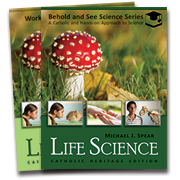Behold and See Life Science (BSLS) is ideal for seventh or eighth grades but it might also be used for ninth grade for students who need a gentler introduction to high school science courses. The course first covers basic chemistry then proceeds from cells up through increasingly complex life forms. About half of the text is devoted to systems of the human body, nutrition, and disease. The text concludes with chapters on animal behavior and reproduction and on ecology.
BSLS is an updated edition of an earlier text written by Michael Spear, last copyrighted in 1998. Significant changes and additions have been made to the original text. Scientific information has been updated along with a number of additions such as hundreds of beautiful images, experiments, and formal lab work. Also new to this edition are articles about scientists—especially Catholic scientists—and other historical figures who tie into the scientific themes—figures such as Hippocrates; Blessed Nicolas Steno, the Father of Modern Geology; Alexander Fleming, the discoverer of penicillin; and Fr. Gregor Mendel, the Father of Modern Genetics. There are a number of other articles on peripherally related topics such as The Christian Family, Love and Responsibility, Redemptive Suffering, and the Myth of Overpopulation.
The course consists of a full-color student text and a black-and-white workbook and lab manual. Mid-term and final reviews that can be used as exams are included in the workbook along with answer keys for the entire workbook as well as the exams. Parents might want to remove these pages since students work directly in the workbook for many of their assignments.
There is no separate teacher guide, but parents need to read the “To the Teacher” section on pages one through four of the workbook. There you will find important instructions on using the workbook activities and exams as well as a supply list. One- and two-year single-subject daily lesson plans are available to purchase for this program. A daily schedule is also available within the CHC Daily Lesson Plans for seventh grade, but it only makes sense to invest in the multi-subject Lesson Plans if you are using other CHC resources for a seventh grade student. It is easy to figure out a schedule without the Lesson Plans since the workbook correlates directly with the text. If you plan to complete one chapter a week in both the text and workbook, that leaves you a few extra weeks to spend on the some of the more time-consuming projects I mention below as well as reviewing for and taking the exams.
The student text is a gorgeous, 275-page softcover book. It is heavily illustrated, and the font size is relatively large so the text material to be read is not overwhelming. However, it does teach serious science including a great deal of scientific vocabulary. The textbook’s view is clearly Christian, viewing God as the creator and designer of life. For example, one article says, “In somewhat the same way, our Intelligent Designer equipped body cells that require lot of ‘fuel’ (like muscles) with an abundance of mitochondria will other cells with ‘low-energy’ needs have only a few” (p. 43). This is in addition to the biographical and topical articles that heavily emphasize the faith of scientists and the faith connections of some topics.
Workbooks have written activities in many different formats from fill-in-the-blanks to writing two research papers. The research papers should only be about 650-750 words long, but they should include works cited. Instructions are included in the workbook. There are also drawing and labeling activities within many workbook chapters. Early in the course, students will begin either a leaf or an insect collection. Just about every one of the 26 chapters in the text has one or more experiments or a formal lab activity, which include step-by-step instructions and use materials which are safe and easy to obtain . The second chapter includes a lesson on the microscope which students will be using in a number of future activities. Some of the experiments are fairly simple, such as creating a slide with onion cells and viewing it with the microscope, but others are relatively complex and further develop the scientific concepts introduced in the textbook.
Formal labs have students walk through all of the steps of formal lab work, although some of the work is already done for them. For example, in the lab on osmosis, the purpose is already stated and the hypothesis only requires students to fill in words in two blanks. The materials, apparatus, and procedure are already written in their workbook. A data table is set up for the student to record observations. Questions are posed that students will answer in complete sentences or paragraphs. The conclusion is stated with only a few words for students to fill in. This “fill-in-the-blank” format allows students who are just learning the laboratory process to perform experiments which might otherwise be too complex for them. This is a fairly easy way for students to learn the laboratory process in preparation for high school and also makes grading the lab reports easier for parents without a science background.
Optional web links are included in the workbook so that students might explore interactive sites, extension activities, or video clips.
The combination of the Behold and See Life Science text with its companion workbook results in a solid life science course with plenty of hands-on activity. It also provides a significant amount of written work that might even meet part of the English language arts requirement for the year. In addition, it makes a gentle, but effective introduction to the lab work students will encounter in high school science courses.








